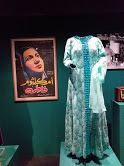The golden
age of arab music and cinema (1930 -70) produced some spectacular women
performers; they are celebrated in the
current exhibition at the Arab Institute in Paris.
The women
featured in the “Divas” exhibition not only held centre stage, but astonished
the world. They came from different backgrounds and origins: Christian, Jewish,
Syria, Lebanon, Egypt, but had one thing in common: star quality.
Of the most
famous four, Oum Kalthoum is a
legend. When she died in 1975, aged approximately 77, she was given a
magnificent state funeral (visible on Youtube). 2 million Egyptians turned out
onto the streets of Cairo to say farewell to their favourite artiste. Her songs
sometimes lasted over an hour, as she improvised, singing of love and pain and
abandonment. Regularly, and for 27 years, starting in 1934, she gave concerts on
Radio Cairo. Her 2 concerts in Paris, at the Olympia concert hall, in 1967,
were the only ones she gave outside of the arab world.
Several of
the dresses worn by the Divas are on display, along with their jewelry. Here is
Oum Khaltoum with some of her accessories.
Warda El Djezairia
(Rose of Algeria)
 |
| Warda |
Later, having divorced him, Warda returned to the stage by special request to perform for Algerian President Boumedienne at the celebrations at the ten year anniversary of Algeria’s independence. Her career was relaunched in Egypt where she married Egyptian composer Baligh Hamdi. Warda represented the unity of the arab world, continuing the heritage of Oum Kalthoum, but incorporating sounds from the Mahgreb.
 |
| Fayrouz |
The third
very famous singer, born in 1935 in Beirut, is Fayrouz. Her name means Turquoise. She was given it by the director
of Radio Lebanon in 1947. Fayrouz has sung everything, from Lebanese folk songs
to Western rhythms and operettas. She has become a living icon, proclaiming
tolerance and love through her songs, often tragic, after the nightmare of
civil war in Lebanon.
Dalida (original name Yolanda Gigliotti), born in Egypt of an Italian family was elected ‘Miss Egypt’ in 1954, wearing an ocelot bikini! She enjoyed huge success as a singer in Europe, especially in France and Italy, despite a tragic life which ended in suicide.
The
highpoint of her film career was in the role of Saddika, laundress, in Youssef
Chahine’s film ‘ The Sixth Day’ (1986). Dalida’s grave, in Montmartre cemetery,
is one of the most visited; its
powerful statue reflects her glamorous career.
 |
| Asmahan |
Asmahan (meaning ‘sublime’), was a great beauty and film star, married a
Syrian prince, entranced audiences with her melancholy songs, led a turbulent
life, and died in mysterious
circumstances in a car crash, possibly involved in espionnage, at 31 years of
age.
 |
| Tahiyya Carioca |
Tahiyya Carioca (1919-1999) ran away from home at twelve years old and made a career as an oriental dancer, sensual and slow. Her temperament however was volcanic. Her marriages numbered fourteen! In 1953 she was imprisoned for 3 months, for her Communist activities. In her career, she made over 120 films, often playing a seductress.
Such women became icons and also symbols of emancipation.
Civil wars,
petrol crises and the death of Egyptian
President Nasser in 1970 brought to an end the golden era.
The exhibition takes
us through these heady years, allowing us to hear the voices and see several film
clips of the great Divas.
Contemporary art looks back to these women, as it seeks to redefine the place of women in society.
An art installation, specially created by Lamia Ziadé for the show, is a transposition of her novel “Oh Night, Oh my eyes”. It transports us into the fantasy world of these performers, as if we were entering into one of their dressing rooms.
The exhibition runs until the 26th of September.
It is open
from Tuesday to Friday 1pm to 6pm.
On
Saturdays, Sundays and holidays from 10am to 7pm.
This article was first published on eye prefer Paris. Link:












Comments
Post a Comment